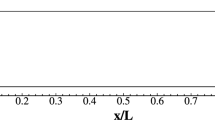Abstract
CFD analysis has become an essential tool in ship hydrodynamics both for practical design applications and for engineering researches. However, although much efforts are being devoted to the development of turbulence modeling, universal turbulence models which can be applied to a wide class of flows are not yet established. Particularly, ship flows are characterized as turbulent flows with separation around complex geometry and this makes the modeling even more difficult. In the current ship flow simulations, the turbulence model must be carefully selected from the experiences and the optimal model varies case by case. Recently, a new concept is proposed for expanding flexibility and applicability of a RANS turbulence model. This approach called GEKO (GEneralized K-Omega) applies a modification to the existing k-\(\omega \) SST model by adding free parameters to control the various properties, such as separation, curvature correction, near wall treatment, and so on. Inspired by this approach, the parameter tuning of the SST model is attempted in the present study to improve the prediction capability of the k-\(\omega \) turbulence model for ship resistance flow applications.

















Similar content being viewed by others
References
Bradshaw P (1969) The analogy between streamline curvature and buoyancy in turbulent shear flow. J Fluid Mech 36:177–191
Hellsten A (1998) Some improvements in menter’s k-omega SST turbulence model. Proc. 29th AIAA fluid dynamics conference. June 15–18, Albuquerque, USA
Hino T (1997) A 3D unstructured grid method for incompressible viscous flows. J Soc Naval Architects Japan 182:9–15
Hino T, Hirata N, Ohashi K, Toda Y, Zhu T, Makino K, Takai M, Nishigaki M, Kimura K, Anda M, Shingo S (2016) Hull form design and flow measurements of a bulk carrier with an energy-saving device for CFD validations, Proc. 13th International Symposium on Practical Design of Ships and other floating structures (PRADS), September 4-9, Copenhagen, Denmark
Hino T, Suzuki K, Xu H, Takagi Y (2020) Parameter Tuning of \(k\)-\(\omega \) Turbulence Model for Ship Flow Simulation. Conference Proceedings, Japan Society of Naval Architects and Ocean Engineers 30:545–550
Hino T, Stern F, Larsson L, Visonneau M, Hirata N, Kim J, (eds) (2021) Numerical Ship Hydrodynamics. An assessment of the Tokyo 2015 Workshop, Springer Nature, Switzerland
Hirata N, Kobayashi H, Hino T, Toda Y, Abdel-Maksoud M, Stern F (2021) Experimental data for JBC resistance, sinkage, trim, self-propulsion factors, longitudinal wave cut and detailed flow with and without an energy saving circular duct. Numerical Ship Hydrodynamics. An assessment of the Tokyo 2015 Workshop. Springer, 23-52
Larsson L (2021) Evaluation of resistance, sinkage, trim and wave pattern predictions for JBC. Numerical Ship Hydrodynamics. An assessment of the Tokyo 2015 Workshop. Springer, 139-157
Menter FR (1994) Two-equation Eddy-viscosity turbulence models for engineering applications. AIAA J 32(8):1598–1605
Menter FR, Lechner R (2019) Best practice: generalized k-\(\omega \) two-equation turbulence model in ANSYS CFD (GEKO), Tech Rep ANSYS
Nair AS, Mathew MP (2022) Resistance estimation of ships using GEKO turbulence model in ANSYS Fluent, Proc. OCEANS 2022, February 21-24, Chennai, India
Pena B, Huang L (2021) A review on the turbulence modelling strategy for ship hydrodynamic simulations. Ocean Eng 241:110082
Sharkey PS, Menter FR (2019) A numerical investigation of the turbulent flow around a scale model JBC hull using the generalized k-\(\omega \) (GEKO) turbulence model. Proc. 11th International Workshop on Ship and Marine Hydrodynamics September 22–25, Hamburg, Germany
Terziev M, Tezdogan T, Incecik A (2020) Application of eddy-viscosity turbulence models to problems in ship hydrodynamics. Ships Offshore Struct 15(5):511–534
Visonneau M (2021) Analysis of the local flow around JBC, Numerical Ship Hydrodynamics. An assessment of the Tokyo 2015 Workshop. Springer, 159–278
Xing T, Stern F (2010) Factors of safety for richardson extrapolation. J Fluid Eng 132:061403-1–13
Author information
Authors and Affiliations
Contributions
Conceptualization: [TH]; Methodology: [TH, KS]; Formal analysis and investigation: [KS]; Writing—original draft preparation: [TH]; Writing—review and editing: [YT]; Resources: [TH]; Supervision: [TH, YT].
Corresponding author
Ethics declarations
Conflict of interest
The authors declare that they have no known competing financial interests or personal relationships that could have appeared to influence the work reported in this paper.
Additional information
Publisher's Note
Springer Nature remains neutral with regard to jurisdictional claims in published maps and institutional affiliations.
Rights and permissions
Springer Nature or its licensor holds exclusive rights to this article under a publishing agreement with the author(s) or other rightsholder(s); author self-archiving of the accepted manuscript version of this article is solely governed by the terms of such publishing agreement and applicable law.
About this article
Cite this article
Hino, T., Suzuki, K. & Takagi, Y. Modification of k-\(\omega \) turbulence model for ship resistance flow predictions. J. Ocean Eng. Mar. Energy 8, 527–538 (2022). https://doi.org/10.1007/s40722-022-00259-6
Received:
Accepted:
Published:
Issue Date:
DOI: https://doi.org/10.1007/s40722-022-00259-6



